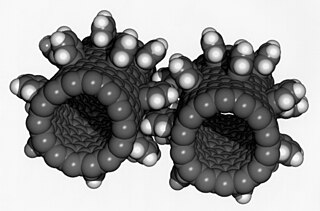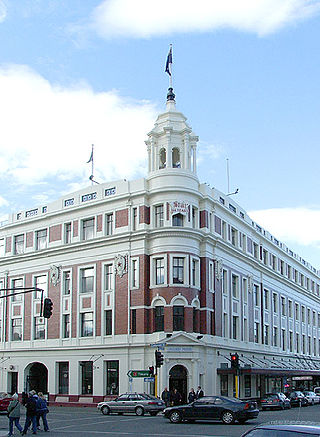
Nanotechnology was defined by the National Nanotechnology Initiative as the manipulation of matter with at least one dimension sized from 1 to 100 nanometers (nm). At this scale, commonly known as the nanoscale, surface area and quantum mechanical effects become important in describing properties of matter. The definition of nanotechnology is inclusive of all types of research and technologies that deal with these special properties. It is therefore common to see the plural form "nanotechnologies" as well as "nanoscale technologies" to refer to the broad range of research and applications whose common trait is size. An earlier description of nanotechnology referred to the particular technological goal of precisely manipulating atoms and molecules for fabrication of macroscale products, also now referred to as molecular nanotechnology.

Nanomaterials describe, in principle, materials of which a single unit is sized between 1 and 100 nm.

The Otago Daily Times (ODT) is a newspaper published by Allied Press Ltd in Dunedin, New Zealand. The ODT is one of the country's four main daily newspapers, serving the southern South Island with a circulation of around 26,000 and a combined print and digital annual audience of 304,000. Founded in 1861 it is New Zealand's oldest surviving daily newspaper – Christchurch's The Press, six months older, was a weekly paper until March 1863.

Alan Graham MacDiarmid, ONZ FRS was a New Zealand-born American chemist, and one of three recipients of the Nobel Prize for Chemistry in 2000.

A nanoparticle or ultrafine particle is a particle of matter 1 to 100 nanometres (nm) in diameter. The term is sometimes used for larger particles, up to 500 nm, or fibers and tubes that are less than 100 nm in only two directions. At the lowest range, metal particles smaller than 1 nm are usually called atom clusters instead.

Nanocomposite is a multiphase solid material where one of the phases has one, two or three dimensions of less than 100 nanometers (nm) or structures having nano-scale repeat distances between the different phases that make up the material.
Magnetic-activated cell sorting (MACS) is a method for separation of various cell populations depending on their surface antigens invented by Miltenyi Biotec. The name MACS is a registered trademark of the company.

Thalappil Pradeep is an institute professor and professor of chemistry in the Department of Chemistry at the Indian Institute of Technology Madras. He is also the Deepak Parekh Chair Professor. In 2020 he received the Padma Shri award for his distinguished work in the field of Science and Technology. He has received the Nikkei Asia Prize (2020), The World Academy of Sciences (TWAS) prize (2018), and the Shanti Swarup Bhatnagar Prize for Science and Technology in 2008 by Council of Scientific and Industrial Research.
Magnetic nanoparticles (MNPs) are a class of nanoparticle that can be manipulated using magnetic fields. Such particles commonly consist of two components, a magnetic material, often iron, nickel and cobalt, and a chemical component that has functionality. While nanoparticles are smaller than 1 micrometer in diameter, the larger microbeads are 0.5–500 micrometer in diameter. Magnetic nanoparticle clusters that are composed of a number of individual magnetic nanoparticles are known as magnetic nanobeads with a diameter of 50–200 nanometers. Magnetic nanoparticle clusters are a basis for their further magnetic assembly into magnetic nanochains. The magnetic nanoparticles have been the focus of much research recently because they possess attractive properties which could see potential use in catalysis including nanomaterial-based catalysts, biomedicine and tissue specific targeting, magnetically tunable colloidal photonic crystals, microfluidics, magnetic resonance imaging, magnetic particle imaging, data storage, environmental remediation, nanofluids, optical filters, defect sensor, magnetic cooling and cation sensors.
Cuprospinel is a mineral. Cuprospinel is an inverse spinel with the chemical formula CuFe2O4, where copper substitutes some of the iron cations in the structure. Its structure is similar to that of magnetite, Fe3O4, yet with slightly different chemical and physical properties due to the presence of copper.

Nicola Gaston is a Professor and a former President of the New Zealand Association of Scientists. She is a materials scientist who has worked on nanoparticles, and has spoken out on sexism in the scientific research establishment. In 2023 she was awarded the Thomson Medal.

Steven Peter Armes is a Professor of polymer chemistry and colloid chemistry at the University of Sheffield.

In materials and electric battery research, cobalt oxide nanoparticles usually refers to particles of cobalt(II,III) oxide Co
3O
4 of nanometer size, with various shapes and crystal structures.

Yurii Gun'ko, born in USSR, Belarusian scientists, professor of Inorganic Chemistry at School of Chemistry of Trinity College Dublin, head of the International research and education centre for physics of nanostructures.

Douglas Kerr MacDiarmid was a New Zealand expatriate painter, known for his diversity and exceptional use of colour, and involved with key movements in twentieth-century art. He lived in Paris, France, for most of his career.
The Prime Minister's Science Prizes are awarded yearly by the Prime Minister of New Zealand. They were first awarded in 2009 in order to raise the profile and prestige of science among New Zealanders. The 2019 awards were presented in early 2020.
Alison Marion Cree is a New Zealand herpetologist. She is currently a professor at Otago University.
Ambarish Ghosh is an Indian scientist, a faculty member at the Centre for Nano Science and Engineering (CeNSE), Indian Institute of Science, Bangalore. He is also an associate faculty at the Department of Physics. He is known for his work on nanorobots, active matter physics, plasmonics, metamaterials and electron bubbles in liquid helium.
Serena Corr is a chair in Functional Materials and Professor in Chemical and Biological Engineering at the University of Sheffield. She works on next-generation battery materials and advanced characterisation techniques for nanomaterials.
Sara A. Majetich is an American physicist and Professor of Physics at Carnegie Mellon University. Her work considers magnetic nanoparticles and nanostructures for application in spintronic devices. She is a Fellow of the American Physical Society and the Institute of Electrical and Electronics Engineers.









